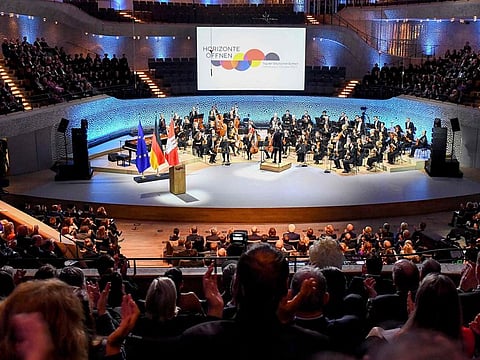From the Berlin Wall to Unity Day: The significance of German reunification
Economic gap and social differences are some effects of reunification still visible

Each year on October 3 Germany observes its “Tag der Deutschen Einheit,” the anniversary of the day in 1990 when East and West Germany reunified after almost 45 years apart. The Chancellor of West Germany at the time of reunification, Helmut Kohl, voiced the sentiment that “German unity was achieved not through the power of our arms, but by the strength of our hearts.” The Day of German Reunification is celebrated as a national holiday in Germany, marked by various events and festivities. It is generally viewed with pride and as a symbol of progress, however, opinions on reunification can vary among Germans.
While the shame and trauma of the Nazi regime and the Second World War will forever be part of Germany’s history, the process of reunification and the subsequent transformation of the country helped many older Germans regain a sense of pride and identity based on democratic values, peaceful cooperation, and a commitment to reconciliation and responsibility for the past. German reunification symbolised a new beginning for the nation, one that emphasised unity, democracy, and its place in a united Europe and the world. Younger Germans, especially those who were born after reunification, may not have the same emotional connection to the event. For them, the division of Germany may be more of a historical fact rather than a personal experience.
Differences in perspectives on reunification can still be found between East and West Germans. While there has been significant progress in bridging economic and social disparities between the two regions, some Eastern Germans still feel that they have not fully benefited from reunification in terms of economic opportunities and development.
November 9, 1989: Shattering the past
Unlike many other cases of political change and unification, the process in Germany was largely peaceful. The events leading up to reunification were characterised by peaceful protests, negotiations, and diplomacy rather than armed conflict. Throughout 1989, East Germany experienced a wave of peaceful protests and demonstrations calling for political reforms and greater freedom. These protests, particularly in cities like Leipzig and Dresden, gained momentum and public support.
Erich Honecker, the long-time leader of East Germany, was replaced by Egon Krenz in October 1989. Krenz initiated some political reforms but was unable to quell the protests. This leadership change signalled a willingness on the part of East German authorities to negotiate and compromise. On November 9, 1989, the East German government announced that citizens could travel to West Germany freely. Border guards would no longer patrol the barrier between the two areas. The Berlin Wall, which had stood for nearly three decades, had fallen.
The decline of the Soviet Union influenced Germany’s decision to reunify. USSR leader Mikhail Gorbachev’s policy of glasnost, or openness, reduced tension with the United States, and the US supported German reunification as part of its policy toward a “whole and free” Europe. After the reunification, Soviet troops withdrew troops from East Germany, and relations between the two countries were normalized. The USSR would collapse two years later.
The German reunification process was a complex endeavour, but unlike other efforts in history, such as the former Yugoslavia, Vietnam, and Yemen, the division of Germany was not primarily driven by ethnic, linguistic, or historical factors but rather geopolitical rivalries. East Germany (the German Democratic Republic or GDR) had a significantly less developed economy compared to West Germany (the Federal Republic of Germany or FRG), and transitioning the GDR’s centrally planned economy to a market-oriented system resulted in significant economic disparities and challenges in job creation and infrastructure development in the former East. Harmonising the two Germanys was expensive for the West, who provided significant financial support to the East for infrastructure development and social welfare programmes. Estimates of the total cost of reunification have ranged from hundreds of billions to over a trillion euros.
Reunification also required the integration of the political systems of East and West Germany. This involved dismantling the GDR’s political structures and incorporating former GDR citizens into the democratic institutions of the FRG . It also required dealing with the legacy of the GDR’s authoritarian regime. After German reunification, the German government undertook several measures to deal with the scars left by the GDR’s authoritarian regime. Addressing this legacy was crucial for the process of national reconciliation, the establishment of democratic institutions, and the promotion of human rights and social justice. One of the most significant steps taken was the opening of the archives of the Stasi, the GDR’s secret police. Citizens were granted access to their own Stasi files, allowing them to see the extent of state surveillance and informer networks. This provided transparency and allowed victims to seek justice and accountability.
The effects of reunification on Germany today
The reunification of Europe’s largest economy catalysed deeper European integration by emphasising stability and cooperation. Germany’s active support for the European Union’s expansion eastward brought economic growth to emerging democracies. Moreover, the establishment of the euro currency, backed by Germany’s economic strength, boosted cross-border trade and economic convergence. Germany’s leadership in tackling key EU challenges, from migration to climate change, has reinforced the union’s cohesion.
While significant progress has been made, some lasting effects of the reunification process are still visible in Germany today, particularly in terms of economic disparities and social differences. All in all, however, reunification has led to a stronger and more unified Germany with a more prominent role in European and international affairs. This is something the Germans should be proud be of as they celebrate this historic moment.
— Dr Kristian Alexander, a German native, is a Senior Fellow and the Director of the International Security & Terrorism Program at TRENDS Research & Advisory, Dubai, UAE.
Sign up for the Daily Briefing
Get the latest news and updates straight to your inbox







